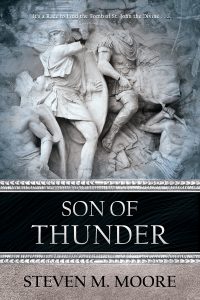Gotcha!
Any novel worth the name has a lot of words. Mine are generally between 65 and 85 kwords in length without counting front and back material. There’s always a chance that a few editing errors remain. Annoying reviewers focus on them, some even going so far as to state, “Look, another poorly edited self-published (or small press) book.” I resent such remarks because, in my case, I go through an extensive editing process.
I catch many copy-editing errors myself in reading or reviewing mode, even in those TV banners that go by so fast that the average viewer probably doesn’t notice. (For example, a recent ABC news item had one about “gama rays.” From some new sci-fi weapon?) I have an eagle’s eye for editing, but even an eagle misses his prey sometimes!
First, let me state that I often notice errors even in traditionally published books from the Big Five. No editing process is perfect. Of course, that’s no excuse for others’ or mine. We can complain that reviewers are probably more lenient with a Baldacci or Deaver book. (NY Times reviewers certainly are, and their favoritism goes to the extreme of never mentioning editing errors, bless their biased souls.) That’s like most things in this life: The rich and famous get a pass when they screw up, while us poor clods take the heat!
Second, I edit my books to hell! SOP: Two edits from me (again I’m referring to copy editing—I content edit as I go), one on screen and the other with the printed manuscript (a different look); a beta-read and edit from a pro to catch any remaining errors (even though I send this person a very clean manuscript), beta-reading to check for logical lapses and more copy editing for the errors my old eyes didn’t catch; and proof reading after formatting (that process can create errors not in the manuscript). For my traditionally published works, I have to suffer through the publisher’s editing “corrections,” many of those reducing to my preference for the NY Times style manual over the antiquated and incorrect Chicago one that orgs like ITW force publishers to follow and no author can afford. After all this, errors can still remain.
As a reader, I’m tolerant of editing errors…up to a point. I know a book is similar to computer code because I’ve written both (an ebook is computer code): There’s always another bug! (Even in Big Five books…and they steal a lot of royalties to pay for those staff editors!) But like computer code, editing errors are egregious only when they keep the code itself from doing its job (the reader isn’t clear what the author intends).

As a reviewer, I’m also tolerant, albeit a bit more demanding, especially about content editing, which no copy editor should be allowed to do! I content edit as I go and feel that’s more the author’s responsibility to make sure the story is logical and a faithful representation of his personal style. An editor might be asked to save a book, or be so bold to presume he can make it better (meaning make it look like he wrote it!), but authors should resist that. (I almost withdrew the manuscript of Son of Thunder because a brash editor insisted on “improving it”—he didn’t, but he didn’t completely ruin it, so I threw up my hands and said to myself, “Screw it!” because I already knew that small press and I would soon go through a divorce. (Their insistence on changes was just one of the final straws.)

As an author, I know I have to own all the editing errors that remain, even though someone else missed them, or even created them. That’s the fate of any working group leader getting the code ready for a software project. Well, almost. The formatting process for a book is now often done with software, which is more computer code, code that’s allowed to change other code! I refuse to share those errors, but knowing they exist, I grin and bear the proof-reading chore. (That aforementioned small press also irked me by changing to Ingram’s clunky formatting software, making that proofing hellish!) Errors in formatting code can create errors in the final product. Sometimes they can’t even be fixed! (Consider the margins in Son of Thunder and Death on the Danube, two different formatting engines.)
I’m posting this article so readers can understand what goes on behind the scenes after I finish a manuscript. It’s easy to publish a book nowadays, but the process can never be perfect. Think about that why you’re cursing and saying, “How could author X let that error get by?” X might be a beta-reader, editor, or formatting software, and not the author! My advice: Don’t dwell on the errors if you’re enjoying the storytelling.
***

Comments are always welcome.
Palettes, Patriots, and Prats: Esther Brookstone, Book Four. After book three in this series, you might have thought that I’d leave it as a trilogy and send newlyweds Esther and Bastiann van Coevorden off to enjoy their golden years in peace. Ha! Not with my muses, who are really banshees with Tasers. This one starts with an innocent castle tour with a duke and duchess, but trouble soon finds the artist of a painting the crime-fighting duo observes there. Esther and Bastiann become embroiled yet again in fighting an international conspiracy. Available wherever quality ebooks are sold (not on Amazon or Smashwords).
Around the world and to the stars! In libris libertas!
